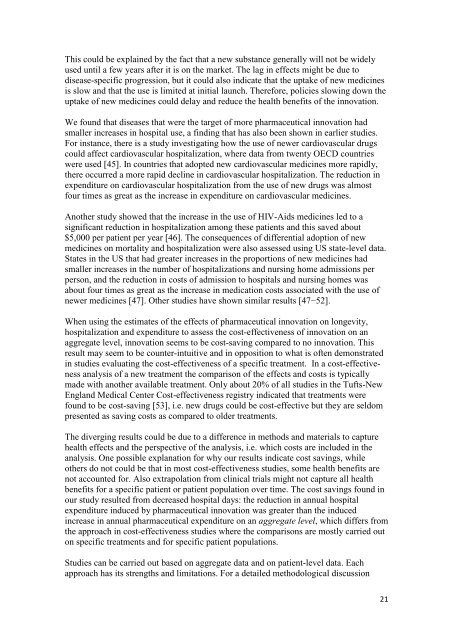Billie Pettersson and Frank R. Lichtenberg - SNS
Billie Pettersson and Frank R. Lichtenberg - SNS
Billie Pettersson and Frank R. Lichtenberg - SNS
Create successful ePaper yourself
Turn your PDF publications into a flip-book with our unique Google optimized e-Paper software.
This could be explained by the fact that a new substance generally will not be widelyused until a few years after it is on the market. The lag in effects might be due todisease-specific progression, but it could also indicate that the uptake of new medicinesis slow <strong>and</strong> that the use is limited at initial launch. Therefore, policies slowing down theuptake of new medicines could delay <strong>and</strong> reduce the health benefits of the innovation.We found that diseases that were the target of more pharmaceutical innovation hadsmaller increases in hospital use, a finding that has also been shown in earlier studies.For instance, there is a study investigating how the use of newer cardiovascular drugscould affect cardiovascular hospitalization, where data from twenty OECD countrieswere used [45]. In countries that adopted new cardiovascular medicines more rapidly,there occurred a more rapid decline in cardiovascular hospitalization. The reduction inexpenditure on cardiovascular hospitalization from the use of new drugs was almostfour times as great as the increase in expenditure on cardiovascular medicines.Another study showed that the increase in the use of HIV-Aids medicines led to asignificant reduction in hospitalization among these patients <strong>and</strong> this saved about$5,000 per patient per year [46]. The consequences of differential adoption of newmedicines on mortality <strong>and</strong> hospitalization were also assessed using US state-level data.States in the US that had greater increases in the proportions of new medicines hadsmaller increases in the number of hospitalizations <strong>and</strong> nursing home admissions perperson, <strong>and</strong> the reduction in costs of admission to hospitals <strong>and</strong> nursing homes wasabout four times as great as the increase in medication costs associated with the use ofnewer medicines [47]. Other studies have shown similar results [47−52].When using the estimates of the effects of pharmaceutical innovation on longevity,hospitalization <strong>and</strong> expenditure to assess the cost-effectiveness of innovation on anaggregate level, innovation seems to be cost-saving compared to no innovation. Thisresult may seem to be counter-intuitive <strong>and</strong> in opposition to what is often demonstratedin studies evaluating the cost-effectiveness of a specific treatment. In a cost-effectivenessanalysis of a new treatment the comparison of the effects <strong>and</strong> costs is typicallymade with another available treatment. Only about 20% of all studies in the Tufts-NewEngl<strong>and</strong> Medical Center Cost-effectiveness registry indicated that treatments werefound to be cost-saving [53], i.e. new drugs could be cost-effective but they are seldompresented as saving costs as compared to older treatments.The diverging results could be due to a difference in methods <strong>and</strong> materials to capturehealth effects <strong>and</strong> the perspective of the analysis, i.e. which costs are included in theanalysis. One possible explanation for why our results indicate cost savings, whileothers do not could be that in most cost-effectiveness studies, some health benefits arenot accounted for. Also extrapolation from clinical trials might not capture all healthbenefits for a specific patient or patient population over time. The cost savings found inour study resulted from decreased hospital days: the reduction in annual hospitalexpenditure induced by pharmaceutical innovation was greater than the inducedincrease in annual pharmaceutical expenditure on an aggregate level, which differs fromthe approach in cost-effectiveness studies where the comparisons are mostly carried outon specific treatments <strong>and</strong> for specific patient populations.Studies can be carried out based on aggregate data <strong>and</strong> on patient-level data. Eachapproach has its strengths <strong>and</strong> limitations. For a detailed methodological discussion21
















